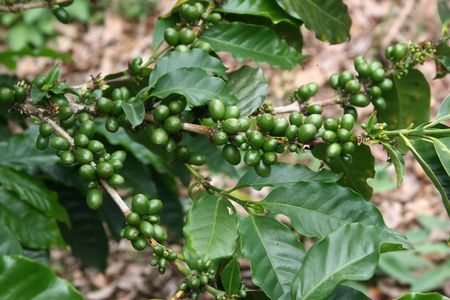Green Coffee - Coffea arabica

Common Names: Green coffee, Raw coffee beans, Unroasted coffee beans, Coffea arabica, Arabica coffee, Coffee shrub, International: Green Coffee Beans
Latin Name: Coffea arabica
Origin: Africa, Asia, Australia, South America
Short Introduction
Green coffee consists of raw, unroasted beans from Coffea arabica, known for their high content of beneficial polyphenols and natural caffeine. These beans are popular for their antioxidant properties and their support for metabolism and healthy weight management.
Detailed Description
Green coffee beans are simply unroasted coffee beans, and unlike their roasted counterparts, they retain a much higher content of beneficial health compounds. Research shows that the reputation of green coffee is largely due to its high content of polyphenols, most notably chlorogenic acid. The roasting process can destroy up to 70% of this valuable compound.
Botanical Information
Green coffee comes from the seeds of Coffea arabica, a shrub native to tropical regions of Africa, now widely cultivated in warm climates across the world. These raw beans are harvested, dried, and left unroasted, preserving a range of bioactive phytochemicals.
Usage / Dosage
Chlorogenic acid, the main polyphenol in green coffee, plays a role in regulating the activity of the enzyme glucose-6-phosphatase. This enzyme is involved in gluconeogenesis, helping to maintain blood glucose homeostasis. Research focused on green coffee with a high concentration of chlorogenic acid suggests it significantly affects the absorption of glucose from food, as seen in studies where this compound reduced the absorption of both glucose and insulin spikes. This effect has two notable health benefits: first, by reducing sugar absorption, it lowers the risk of excess sugar being converted and stored as body fat; second, it lowers the glycemic index of consumed food, potentially helping in the prevention of type 2 diabetes.
Additional studies, including a 2011 report, found that the polyphenols abundant in green coffee beans stimulate energy metabolism and reduce the formation and storage of body fat (lipogenesis). Numerous analyses of green coffee extract show that its supplementation may lead to a reduction of body fat and weight loss.
Within the digestive tract, chlorogenic acid is hydrolyzed into caffeic and quinic acids, both recognized as significant antioxidants.
Antioxidants are essential for neutralizing free radicals—harmful molecules formed during oxidation and worsened by unhealthy lifestyle choices such as smoking, poor diet, excessive sun exposure, and stress. Excess free radicals can lead to oxidative stress, which damages cells, accelerates aging, and is linked to many serious illnesses, including cancer. Polyphenols like chlorogenic acid are classified as antioxidants. Their antioxidant activity is often measured by their ability to inhibit oxidation of LDL cholesterol and neutralize free radicals. For some people, especially those who consume little fruit and vegetables but drink coffee regularly, coffee is a major source of vital antioxidants.
Like traditional coffee, green coffee extract naturally contains caffeine. The well-known effects of caffeine include increasing alertness, enhancing endurance, boosting concentration and mental focus, as well as acting as a mild diuretic. To counteract the dehydrating effects of caffeine, it is advisable to stay well-hydrated when consuming green coffee extract.
Green coffee extract contains compounds that can support your metabolism and help reduce the storage of excess fat; however, it should ideally be used as a supplement within a balanced diet and healthy lifestyle, which includes nutritious foods and increased physical activity.
